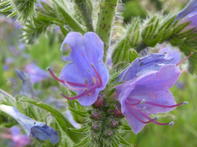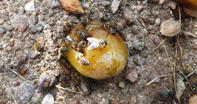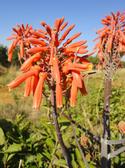Honey bees require food for survival and reproduction. They need carbohydrates (sugars in nectar or honey), amino acids (protein from pollen), lipids (fatty acids, sterols), vitamins, minerals (salts) and water.

Honey bees need a diet rich in a diversity of pollen sources to be able to manufacture various enzymes. These enzymes are necessary to detoxify their bodies from pesticides and diseases and build strong and resistant immune systems.
Often a poor immune system, which leads to malnourishment and starvation is the major cause of bee deaths. Stronger well-fed bees are likely to better survive droughts and winter and rear more young bees than those that did not receive supplementary bee feeding.
When to Feed Bees
Feeding of bees is necessary when a bee colony is low in stored food supplies and when there is little natural forage. In South Africa, only about 12% of the land can be used for crop production such as fruit trees, while natural bee forage like fynbos in the Western Cape is also limited. Natural forage is further reduced by droughts and wildfires.
Honey in the hive is a food source for bees during winter months and at times of shortage of nectar-rich flowering plants. During a drought or when nectar is unavailable, bees use these honey stores in the hive to survive. Often supplementary feeding of bees is also needed after the harvesting of honey.
It is therefore vital for a beekeeper to frequently monitor the amount of honey in the hive to gauge if supplementary bee feeding is necessary or if the hives need to be moved to an area with more natural forage.
Supplementary feeding is often given just before a possible stressful event such as a honey harvest, moving the hive for a pollination service and before splitting a colony. Supplementary feeding can also improve the colony’s and queen’s health.
What to Feed Honeybees?

Feeding Bees - Sugar
Do not feed honey to bees unless it is from your own hives. Bee diseases such as American foulbrood can be spread through honey and may cause an infection in your hive. Also, the smell of honey may attract robbing bees to enter the hive. Rather feed ordinary white table sugar or syrup made with white sugar and water.
Never use raw sugar, brown sugar or molasses as these may cause diarrhoea in bees. Some beekeepers prefer a ratio of one part of sugar to one part of water (a 1:1 dilution) while others prefer a thicker syrup of two parts of sugar to one part of water (2:1).
Warm water helps to dissolve sugar, but the sugar mix should not be heated or boiled as this will caramelise the sugar. In general, a 1:1 syrup will supplement honey stores and stimulate colonies to produce a new brood of bees.
The thicker syrup is used to provide food when honey stores in the hive are low. It is recommended to start feeding about 1 litre of syrup. This should be enough for a few days. Place syrup in a shallow tray under the hive lid and place some grass straws, twigs or stones for bees to reach the syrup without falling in and drowning.
Feeding Bees - Pollen

Pollen is best supplied by a variety of pollen-bearing plants in the vicinity of the hive but shortages can occur in early spring. Honeybees prefer pollen with a protein content of over 25%. Pollen sources include sunflower (14%), eucalyptus (20%) and Aloe davyana (28%).
Canola pollen has similar high protein levels. In times of scarcity, pollen can be supplemented by using pollen substitutes (buy from bee equipment suppliers) or natural pollen.
Pollen can also carry and transmit bee disease so when supplementing with natural pollen, only collect pollen from a strong and disease-free colony. Dr. Eric C. Mussen, of The University of California Davis, in the USA also recommends feeding brewer’s yeast, a low-cost substance similar to pollen in its nutritional content.
It can be dry-fed to the bees, but they assimilate it much better when it has a consistency similar to peanut butter. Smaller beekeepers (with only a few hives) can mix the yeast with 50% sugar syrup. Wrap in wax paper or plastic bags to keep it moist.
Paarl-based bee farmer Nico Langenhoven has found that feeding a mixture of pollen with 5 to 10% of honey (fed on the brood frames as close as possible to the brood) works best. That said, use the hive’s honey and not honey from an outside hive as it might introduce diseases.
By Marinda Louw